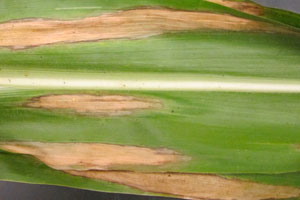US: Weather related diseases infecting some corn crops

Excessive rain, which delayed many Indiana farmers from planting corn, plus the humidity have created an optimum environment for foliar diseases in young crops, according to a Purdue Extension plant pathologist.
Three diseases, which could lead to reduced yields at harvest time, have begun showing in some fields, Kiersten Wise said:
- Grey leaf spot, caused by a fungus, is appearing in the lower canopy of susceptible hybrids across the state.
- Northern corn leaf blight, also caused by a fungus, has been detected in the lower canopy of fields in northern Indiana.
- The bacterial disease Goss’s wilt has been confirmed in plants grown for popcorn and in hybrid corn in northeast Indiana.
Many fields across Indiana are currently at a younger growth stage than normal due to delayed planting and, therefore, may be at greater risk for yield loss due to disease development,” Wise said.
There are fungicides to treat foliar diseases such as grey leaf spot and northern corn leaf blight, she said. In Indiana, they are most effective in preventing loss of yield when applied during the growth stage of tasseling to early silking, or VT-R1. Wise said scouting fields just before tassel emergence (V14) can help determine the level of disease and if a fungicide is warranted.
Wise offers guidance on when fungicides should be considered in Purdue Extension’s Pest and Crop newsletter.
Because Goss’s wilt is a bacterial disease, fungicides will not be effective against it. Although several products are promoted for in-season management of the disease, Wise said, research in Indiana indicates they do not consistently reduce the disease once a plant shows symptoms of it.
Farmers suspecting that Goss’s wilt is in their fields should have a sample analysed by a diagnostic lab, Wise said.
“Fields with confirmed Goss’s wilt should be planted to a hybrid that is more resistant to Goss’s wilt in subsequent years,” Wise said. “Tillage and crop rotation will also help reduce the amount of residue that can harbour bacteria for the next corn crop.”
Wise cautioned that severity of plant diseases can be unpredictable in Indiana even when conditions favour them.
“Before deciding on in-season management of any foliar disease, consider threshold guidelines, cropping practices, planting date, predicted weather conditions and economic factors,” she said, “and manage expectations for what type of yield response an in-season fungicide or bactericide application will provide.”
Join 26,000+ subscribers
Subscribe to our newsletter to stay updated about all the need-to-know content in the feed sector, three times a week. Beheer
Beheer









 WP Admin
WP Admin  Bewerk bericht
Bewerk bericht